Integrating Virtual Reality and Digital Twin in Circular Economy Practices: A Laboratory Application Case
Abstract
1. Introduction
2. Materials and Methods
- (i)
- digitalization of the CE, considering I4.0 technologies as a set of opportunities supporting enterprises in increasing their circular degree;
- (ii)
- the role that I4.0 technologies have in enabling circular business models related to the stakeholder’s involvement (e.g., customers);
- (iii)
- other CE-related aspects (e.g., resource efficiency and lifecycle management), where I4.0 technologies are enablers of innovative ways for monitoring and optimizing resources performances;
- (iv)
- disassembly and supply chain management with I4.0 technologies as element for developing and managing supplier–customer relationships.
2.1. Enabling Technologies
2.1.1. Cyber Physical Systems
2.1.2. Internet of Things
2.1.3. Simulation
2.1.4. Autonomous Robots
2.1.5. Generic Application Cases: I4.0 Technologies Supporting CE Practices
2.1.6. Featured Application Cases: I4.0 Technologies Supporting WEEE Management Practices
2.2. Model Conceptualization
- A simulation model belonging to the manufacturing system design category (i.e., a virtual reality (VR)-based disassembly process configuration model);
- A simulation model belonging to the manufacturing system operation category (i.e., a digital twin (DT)-based real-time process optimization tool)
2.3. Models Development
2.3.1. The Industry 4.0 Lab of Politecnico di Milano
- Front cover;
- Back cover;
- Fuses;
- Printed circuit board (PCB).
- a VR-based configuration tool supporting the disassembly process reconfiguration and implementation; and
- a DT-based configuration tool for a real-time disassembly process monitoring and control.
2.3.2. The VR-Based Configuration Tool
- Disassembly line modelling;
- Disassembly process design;
- Robotic disassembly program coding;
- Disassembly workplan creation within the MES software and process simulation;
- Disassembly configuration uploading on the real system.
Disassembly Line Modelling
Disassembly Process Design
- Step 1—Manual operation: this step refers to the manual removal of back cover and fuses by an operator, by interacting with the line through a human–machine interface (HMI). Given the initial structure of the line (originally designed for assemble products), it was not possible to remove the pressed-back cover. Specifically, robot tools do not currently allow for the removal of the pressed-back cover because it is needed to fix the product on the pallet.
- Step 2—Unscrewing: This step is performed by the drilling station, through the unscrewing of the front cover from the PCB.
- Step 3—PCB removal: This step is performed by the robot station by disassembling the PCB from the front cover and positioning it in a dedicated box. This step enables valuable components recovery (i.e., PCB), making it available for further remanufacturing and recycling activities. This represents the core of the disassembly process, since the program performing this operation has been directly developed and tested in the simulation environment.
- Step 4—Final inspection: The last step is performed by the camera inspection station, which is responsible for checking if the PCB has been correctly removed from the front cover.
Robotic Disassembly Program Coding
Disassembly Workplan Creation within the MES Software and Process Simulation
- (i)
- Define and edit work order flows and process plans;
- (ii)
- Read orders and update status;
- (iii)
- Write allocation of the goods carriers to the order;
- (iv)
- Create warehouse data and material buffer;
- (v)
- Overall equipment effectiveness (OEE) calculation;
- (vi)
- PLC and malfunction report generation, including graphic representation.
Disassembly Configuration Uploading on the Real System
2.3.3. The DT-Based Real-Time Process Optimization Tool
- Advanced connectivity, ensuring real-time data acquisition from the physical world and information feedback from the cyber space;
- Intelligent data management, analytics, and computational capability, constructing the cyber space.
- Connection—data are acquired from machines and their components;
- Conversion—acquired data are transformed into useful information;
- Cyber—information is exploited for building a virtual copy of the real system;
- Cognition—the acquired knowledge is shown to expert users and compared with available information for a self-comparing capability, which improves the decision-making process;
- Configuration—the feedback layer acts on the real system as supervisory control.
- Servers are applications sharing information basing on the OPC-UA information model. Each server defines an address space containing nodes of the OPC-UA model. These nodes represent physical or software objects.
- Clients are applications retrieving information from servers, by browsing and querying the information model.
- Create a real-time connection with workstations—by exploiting the OPC-UA Toolbox in MATLAB®—by accessing to live and historical data directly from MATLAB® and Simulink®;
- Read, write and log in OPC-UA directly from PLCs.
- In general terms, through the Industry 4.0 Lab DT it is possible to
- Identify possible machine states (e.g., errors, failures and downtimes). It is possible to consider CPS as a way to enable either better lifecycle management of products or the development of new services, especially for maintenance reasons [62];
- Identify sensors and actuators states/values (e.g., presence of products, temperature or air consumption), allowing a better monitoring of resource usage within disassembly process (e.g., energy consumption, scrap rates and waste management);
- Monitor and control operations performances;
- Real-time analysis of signals;
- Define maintenance plans of machines;
- Store all the gathered data;
- Execute data analytics on operational and energy parameters.
- (i)
- Setup—in this part, the number of inputs and outputs of the function, their datatype, complexity, and dimensions are defined. Since the model crated is a Discrete Event Simulation, this method includes also the specification of the sample time required for the lecture of sensors values.
- (ii)
- Start—this part performs the initialization activities that the S-function requires, such as allocating memory and setting up user data. This method, as reported in Table 1, allows the connection to the server of interest only at the start of the simulation in Simulink®. Then, after having properly defined the address of each node that it is required to extract from the server, this step allows Simulink® to relate to the specific nodes in real-time.
- (iii)
- Outputs—this part calculates the S-function’s outputs at the current time step and store the results in the run-time object’s OutputPort(n).Data property.
- Identification of the possible machine states;
- Identification of sensors and actuators useful in order to reproduce the machine states identified in the previous step and their combination for the model;
- Analysis of the signal in real-time;
- Storage of the data.
3. Results
3.1. Energy Consumption Optimization
3.1.1. Energy Data Acquisition
- The time spent by the machine in each state ti [s];
- The mean value of the power consumed in each state during the simulation Pi [W];
- The energy consumption in each machine state (Idle, Working, Fault, and Energy Saving) during the simulation Ei = Pi × ti.
3.1.2. Energy Data Analysis
- Active energy—this is the energy from which, in theory, is possible to extract added value for the final product (both for assembly and disassembly processes); and
- Passive energy—this is the energy wasted by the line, i.e., it does not produce any added value to the final product.
- Total energy consumption—this is equal to the overall energy consumed by the line (or a machine if applied to a single station). It is the sum of all the four components shown in Figure 7.
- Operative energy consumption—this is equal to the Total energy consumption minus the passive energy. in other words, it is the sum of the active energy;
- Working energy consumption—this is the sum of the energy consumption in the working state (or the working consumption of the single machine).
- e-Availability—under the energetic perspective, the availability evaluates how much of the total energy consumption is used to perform active operation on the processed piece. The availability is equal to
- e-Performance—from an energetic perspective, the performance evaluates how much of the active power is effectively used to perform operations on the processed product. The performance is equal to
- Quality—defined in the same way as for the time-based perspective so as the ratio between accepted product over the number of products produced:
3.1.3. Energy Data Interface
- Start and Stop buttons—by clicking these two buttons, it is possible to start and to stop the simulation with the DT while data are extracted;
- Analyze button—when the simulation is stopped, it is possible to calculate the e-OEE;
- Energy button—with this button, it is possible to gain access to a graphical interface that plots the power absorbed by each station as function of the time;
- Machine values—for each machine, it shows the state, the CarrierID on which the piece is processed, the number of the process (given from the MES), the actual power consumption, and all the energy consumption discussed before. Also. the result of the camera inspection is available;
- Database generator—this button is available for each station and allows for the generation of the excel file with data gathered.
- The data are clearer, more readable, and do not require the user to be able to read the code that lead to the creation of the DT;
- It is possible to keep the stations under control in real-time and identify immediately what is happening in the production line;
- It is possible to have a direct evaluation of the energetic performance of the line.
3.2. Test of the Disassembly Process
3.3. MES Integration
- The order, already assembled, arrives at the station in charge of checking compliance. If conformity is verified, the process continues, otherwise it does not.
- When compliance is not verified, the DT aborts the current work plan and acts by reactively scheduling a disassembly plan on the same piece.
- For this framework, optimization lies in the autonomous reactive scheduling of a disassembly plan, whether certain compliance conditions are not met.
- An overall scrap reduction with the possibility of materials recovery.
- A work order that plans the assembly of a front cover with a PCB and one or more fuses is planned and launched.
- The Simulink® MATLAB® function checks at every sampled instant if the xResult variable (sensor that detects if the assembly process done so far is compliant to the work plan; this Boolean variable is true if there is compliance, whilst it is false if not) changes its value from true to false.
- When the order approaches the camera inspection workstation and this condition is verified, the xResult becomes false. This means that the work order that is being assembled is not compliant with the workplan expectations. The case analyzed is relative to the work plan that assembles, inside the covers of the prototypical phone, a PCB and one or more fuses. The xResult changing its value to false indicates the lack of fuses on the assembled component, detecting the presence of only the front cover and PCB on the pallet and that at least a fuse is missing from the assembled product. Thus, the simulation code aborts the order that just passed by the camera inspection station thanks to a specific string command sent to the MES.
- As soon as this task is done, a further order with the disassembly work plan is immediately rescheduled on the same pallet, where the front cover with the assembled PCB lies. This work plan has been created and optimized through the first simulation tool described in previous sections.
4. Discussion
- Reconfiguration of the line (originally designed to perform an assembly process) in order to execute EoL disassembly processes, through virtual design, simulation, and optimization with the CIROS® software and its uploading on the real system. System reconfigurability at lower levels has been mainly achieved by changing hardware resources (i.e., change of robot tools for disassembly activities), while at the higher levels, it has been mainly achieved by changing software resources (i.e., robot program coding).
- Creation of a DT of the line, where the data acquired from the field and analyzed in real-time are used to simulate the behavior of the system and allows to evaluate in real-time the energetic performance of the line. This tool allowed possibility for exploiting the IoT for the digitalization of CE practices, by implementing smart disassembly process and dynamic feedback control loops [31].
- Introduction of an energy-based KPI (e-OEE) able to evaluate the energetic performance of the system. This indicator has been introduced in the DT, which is able to extract all the values for real-time energy consumption using an accumulator function. At the end, thanks to the GUI, it is possible to have a clearer and readable way to find useful information for energy management. In this case, CPS and data analytics on energy consumption have been exploited for improving disassembly process performances.
- Integration of the MES to the DT by using a communication protocol, which is able to give commands to the MES from external sources. With this integration, the monitoring DT became a bi-lateral communication-based DT.
- Real validation of application models. The disassembly framework concerns the ability to react to a lack of conformity with respect to work orders. When this predicament occurs, the DT is modelled to abort the non-compliant order and re-schedule a disassembly order to avoid scraps.
5. Conclusions
- Digitalization of the CE, considering I4.0 technologies as a set of opportunities supporting enterprises in increasing their circular degree through the digital optimization of disassembly processes, increasing their capacity to recover valuable components, and improving materials restoration.
- Process effectiveness, whose goal is not to minimize the flow of materials from the BoL to the EoL but to generate a cyclic metabolism, allowing the materials to maintain their original state, thus being continuously used as input for production systems. This is implemented in this work with the exploitation of VR simulation software applied to advanced manufacturing system for the implementation of disassembly processes.
- CE-related aspects (e.g., resource efficiency and lifecycle management), where I4.0 technologies are enablers of innovative ways for monitoring and optimizing resources performances. The aim is to minimize volume and consumption of both energy and material resources. This is implemented in this work by energy data collection and KPI systems creation for decision making process.
Author Contributions
Funding
Conflicts of Interest
Abbreviations
| AR | Augmented Reality |
| BDA | Big Data & Analytics |
| BoL | Beginning of Life |
| CC | Cloud Computing |
| CNC | Computer Numerical Control |
| CPS | Cyber-Physical Systems |
| CE | Circular Economy |
| DES | Discrete Event Simulation |
| DT | Digital Twin |
| e-GUI | energy-Graphical User Interface |
| e-KPI | energy-Key Performance Indicator |
| EoL | End of Life |
| EU | European Union |
| GA | Genetic Algorithm |
| HMI | Human Machine Interface |
| ICT | Information & Communication Technology |
| IoT | Internet of Things |
| ISA | International Standards of Automation |
| I4.0 | Industry 4.0 |
| MES | Manufacturing Execution System |
| M2M | Machine-to-Machine |
| OEE | Overall Equipment Effectiveness |
| OPC-UA | OLE for Process Control-Unified Architecture |
| KPI | Key Performance Indicator |
| PCB | Printed Circuit Board |
| PLC | Programmable Logic Controller |
| RFID | Radio-Frequency IDentification |
| SCADA | Supervisory Control And Data Acquisition |
| SD | System Dynamics |
| VR | Virtual Reality |
| WEEE | Waste from Electrical and Electronic Equipment |
References
- Cucchiella, F.; D’Adamo, I.; Lenny Koh, S.C.; Rosa, P. Recycling of WEEEs: An economic assessment of present and future e-waste streams. Renew. Sustain. Energy Rev. 2015, 51, 263–272. [Google Scholar] [CrossRef]
- Rosa, P.; Terzi, S. Comparison of current practices for a combined management of printed circuit boards from different waste streams. J. Clean. Prod. 2016, 137, 300–312. [Google Scholar] [CrossRef]
- Roblek, V.; Meško, M.; Krapež, A. A complex view of industry 4.0. SAGE Open 2016, 6, 2. [Google Scholar] [CrossRef]
- Ávila-Gutiérrez, M.J.; Martín-Gómez, A.; Aguayo-González, F.; Córdoba-Roldán, A. Standardization framework for sustainability from circular economy 4.0. Sustainability 2019, 11, 6490. [Google Scholar] [CrossRef]
- Rosa, P.; Sassanelli, C.; Urbinati, A.; Chiaroni, D.; Terzi, S. Assessing relations between Circular Economy and Industry 4.0: A systematic literature review. Int. J. Prod. Res. 2019, 58. [Google Scholar] [CrossRef]
- Nobre, G.C.; Tavares, E. Scientific literature analysis on big data and internet of things applications on circular economy: A bibliometric study. Scientometrics 2017, 111, 463–492. [Google Scholar] [CrossRef]
- Frosch, R.A. Industrial ecology: A philosophical introduction. Proc. Natl. Acad. Sci. USA 1992, 89, 800–803. [Google Scholar] [CrossRef]
- Anderberg, S. Industrial metabolism and the linkages between economics, ethics and the environment. Ecol. Econ. 1998, 24, 311–320. [Google Scholar] [CrossRef]
- Chertow, M.R. Industrial symbiosis: Literature and taxonomy. Annu. Rev. Energy Environ. 2000, 25, 313–337. [Google Scholar] [CrossRef]
- Yuan, Z.; Bi, J.; Moriguchi, Y. The circular economy: A new development strategy in China. J. Ind. Ecol. 2006, 10, 4–8. [Google Scholar] [CrossRef]
- Florin, N.; Madden, B.; Sharpe, S.; Benn, S.; Agarwal, R.; Perey, R.; Giurco, D. Shifting Business Models for a Circular Economy: Metals Management for Multi-Product-Use Cycles; UTS: Sydney, Australia, 2015. [Google Scholar]
- The Ellen MacArthur Foundation. Towards a Circular Economy: Business Rationale for an Accelerated Transition; The Ellen MacArthur Foundation: Cowes, UK, 11 March 2015; Available online: https://www.ellenmacarthurfoundation.org/assets/downloads/TCE_Ellen-MacArthur-Foundation_9-Dec-2015.pdf (accessed on 11 March 2020).
- MacArthur, E. Circularity Indicators: An Approach to Measuring Circularity. Methodology 2015. [Google Scholar] [CrossRef]
- ANSI/ISA. Enterprise-Control System Integration—Part 1: Models and Terminology; American National Standards Institute: Washington, DC, USA, 2010. [Google Scholar]
- Pathfinder project. Pointing out research priorities leading to the next generation of simulation and forecasting technologies. 2014. Available online: https://pathfinderproject.eu/downloads/results/Pathfinder_WhitePaper1.pdf (accessed on 11 March 2020).
- Negri, E.; Fumagalli, L.; Macchi, M. A review of the roles of digital twin in CPS-based production systems. Procedia Manuf. 2017, 11, 939–948. [Google Scholar] [CrossRef]
- Fumagalli, L.; Pala, S.; Garetti, M.; Negri, E. Ontology-Based Modeling of Manufacturing and Logistics Systems for a New MES Architecture; Springer: Berlin/Heidelberg, Germany, 2014; pp. 192–200. [Google Scholar]
- Yang, S.; Raghavendra, M.R.A.; Kaminski, J.; Pepin, H. Opportunities for industry 4.0 to support remanufacturing. Appl. Sci. 2018, 8, 7. [Google Scholar] [CrossRef]
- Lee, J.; Bagheri, B.; Kao, H.-A. A cyber-physical systems architecture for industry 4.0-based manufacturing systems. Manuf. Lett. 2015, 3, 18–23. [Google Scholar] [CrossRef]
- Jazdi, N. Cyber physical systems in the context of industry 4.0. In Proceedings of the 2014 IEEE International Conference on Automation, Quality and Testing, Robotics, Cluj-Napoca, Romania, 22–24 May 2014. [Google Scholar] [CrossRef]
- Baheti, R.; Gill, H. Cyber-physical systems. Impact Control Technol. 2011, 12, 161–166. [Google Scholar]
- Stock, T.; Seliger, G. Opportunities of sustainable manufacturing in industry 4.0. Procedia CIRP 2016, 40, 536–541. [Google Scholar] [CrossRef]
- Jabbour, A.B.L.D.S.; Jabbour, C.J.C.; Filho, M.G.; Roubaud, D. Industry 4.0 and the circular economy: A proposed research agenda and original roadmap for sustainable operations. Ann. Oper. Resour. 2018, 270, 273–286. [Google Scholar]
- Bressanelli, G.; Adrodegari, F.; Perona, M.; Saccani, N. Exploring how usage-focused business models enable circular economy through digital technologies. Sustainability 2018, 10, 639. [Google Scholar] [CrossRef]
- Pagoropoulos, A.; Pigosso, D.C.A.; McAloone, T.C. The emergent role of digital technologies in the circular economy: A review. Procedia CIRP 2017, 64, 19–24. [Google Scholar] [CrossRef]
- Davis, J.; Edgar, T.; Porter, J.; Bernaden, J.; Sarli, M. Smart manufacturing, manufacturing intelligence and demand-dynamic performance. Comput. Chem. Eng. 2012, 47, 145–156. [Google Scholar] [CrossRef]
- Lee, J.; Kao, H.; Yang, S. Service innovation and smart analytics for Industry 4.0 and big data environment. Procedia CIRP 2014, 16, 3–8. [Google Scholar] [CrossRef]
- De Man, J.C.; Strandhagen, J.O. An industry 4.0 research agenda for sustainable business models. Procedia CIRP 2017, 63, 721–726. [Google Scholar] [CrossRef]
- Chang, M.M.L.; Ong, S.K.; Nee, A.Y.C. Approaches and challenges in product disassembly planning for sustainability. Procedia CIRP 2017, 60, 506–511. [Google Scholar] [CrossRef]
- Hatzivasilis, G.; Fysarakis, K.; Soultatos, O.; Askoxylakis, I.; Papaefstathiou, I.; Demetriou, G. The industrial Internet of things as an enabler for a circular economy Hy-LP: A novel IIoT protocol, evaluated on a wind park’s SDN/NFV-enabled 5G industrial network. Comput. Commun. 2018, 119, 127–137. [Google Scholar] [CrossRef]
- Reuter, M.A. Digitalizing the circular economy: Circular economy engineering defined by the metallurgical internet of things. Metall. Mater. Trans. B Process Metall. Mater. Process. Sci. 2016, 47, 3194–3220. [Google Scholar] [CrossRef]
- Weyer, S.; Meyer, T.; Ohmer, M.; Gorecky, D.; Zühlke, D. Future modeling and simulation of CPS-based factories: An example from the automotive industry. IFAC PapersOnLine 2016, 49, 97–102. [Google Scholar] [CrossRef]
- Legat, C.; Seitz, C.; Lamparter, S.; Feldmann, S. Semantics to the shop floor: Towards ontology modularization and reuse in the automation domain. IFAC Proc. Vol. 2014, 47, 3444–3449. [Google Scholar] [CrossRef]
- Negri, E.; Fumagalli, L.; Garetti, M.; Tanca, L. Computers in industry requirements and languages for the semantic representation of manufacturing systems. Comput. Ind. 2016, 81, 55–66. [Google Scholar] [CrossRef]
- Posada, J.; Toro, C.; Barandiaran, I.; Oyarzun, D.; Stricker, D.; de Amicis, R.; Pinto, E.B.; Eisert, P.; Döllner, J.; Vallarino, I. Visual computing as a key enabling technology for industrie 4.0 and industrial internet. IEEE Comput. Graph. Appl. 2015, 35, 26–40. [Google Scholar] [CrossRef]
- Cimino, C.; Negri, E.; Fumagalli, L. Review of digital twin applications in manufacturing. Comput. Ind. 2019, 113, 103130. [Google Scholar] [CrossRef]
- Wang, X.V.; Wang, L. Digital twin-based WEEE recycling, recovery and remanufacturing in the background of Industry 4.0. Int. J. Prod. Res. 2019, 57, 3892–3902. [Google Scholar] [CrossRef]
- Merdan, M.; Lepuschitz, W.; Meurer, T.; Vincze, M. Towards ontology-based automated disassembly systems. In Proceedings of the IECON 2010—36th Annual Conference on IEEE Industrial Electronics Societyp, Glendale, AZ, USA, 7–10 November 2010. [Google Scholar] [CrossRef]
- PricewaterhouseCoopers (PWC), Making business and economic sense of climate change: Pwc sustainability and climate change blog. Available online: https://www.pwc.com/gx/en/services/sustainability.html. (accessed on 13 March 2020).
- French, R.; Benakis, M.; Marin-Reyes, H. Intelligent sensing for robotic re-manufacturing in aerospace—An industry 4.0 design based prototype. In Proceedings of the IRIS 2017—5th IEEE International Symposium on Robotics and Intelligent Sensors, Ottawa, ON, Canada, 5–7 October 2017; pp. 272–277. [Google Scholar] [CrossRef]
- Barbosa, J.; Leitão, P.; Trentesaux, D.; Colombo, A.W.; Karnouskos, S. Cross benefits from cyber-physical systems and intelligent products for future smart industries. In Proceedings of the INDIN 2016—14th IEEE International Conference on Industrial Informatics, Poitiers, France, 19–21 July 2016; pp. 504–509. [Google Scholar] [CrossRef][Green Version]
- Hehenberger, P.; Vogel-Heuser, B.; Bradley, D.; Eynard, B.; Tomiyama, T.; Achiche, S. Design, modelling, simulation and integration of cyber physical systems: Methods and applications. Comput. Ind. 2016, 82, 273–289. [Google Scholar] [CrossRef]
- Schroeder, G.N.; Steinmetz, C.; Pereira, C.E.; Espindola, D.B. Digital twin data modeling with automationml and a communication methodology for data exchange. IFAC PapersOnLine 2016, 49, 12–17. [Google Scholar] [CrossRef]
- Schroeder, G.N.; Rodrigues, R.; Espindola, D.; Garcia, N.; Muller, I. Visualising the digital twin using web services and augmented reality. In Proceedings of the INDIN’ 16—14th IEEE International Conference on Industrial Informatics, Poitiers, France, 19–21 July 2016; pp. 522–527. [Google Scholar] [CrossRef]
- D’Adamo, I.; Ferella, F.; Gastaldi, M.; Maggiore, F.; Rosa, P.; Terzi, S. Towards sustainable recycling processes: Wasted printed circuit boards as a source of economic opportunities. Resour. Conserv. Recycl. 2019, 149, 455–467. [Google Scholar] [CrossRef]
- Ji, L.; Liu, C.; Huang, L.; Huang, G. The evolution of Resources Conservation and Recycling over the past 30 years: A bibliometric overview. Resour. Conserv. Recycl. 2018, 134, 34–43. [Google Scholar] [CrossRef]
- Goodall, P.A.; Sharpe, R.G.; West, A.A. A data-driven simulation to support remanufacturing operations. Comput. Ind. 2019, 105, 48–60. [Google Scholar] [CrossRef]
- Alqahtani, A.Y.; Gupta, S.M.; Nakashima, K. Warranty and maintenance analysis of sensor embedded products using internet of things in industry 4.0. Int. J. Prod. Econ. 2019, 208, 483–499. [Google Scholar] [CrossRef]
- Joshi, A.D.; Gupta, S.M. Evaluation of design alternatives of End-Of-Life products using internet of things. Int. J. Prod. Econ. 2019, 208, 281–293. [Google Scholar] [CrossRef]
- Marconi, M.; Germani, M.; Mandolini, M.; Favi, C. Applying data mining technique to disassembly sequence planning: A method to assess effective disassembly time of industrial products applying data mining technique to disassembly sequence planning: A method to assess effective disassembly time of industry. Int. J. Prod. Res. 2018, 57, 599–623. [Google Scholar] [CrossRef]
- Sharpe, R.G.; Goodall, P.A.; Neal, A.D.; Conway, P.P.; West, A.A. Cyber-physical systems in the re-use, refurbishment and recycling of used electrical and electronic equipment. J. Clean. Prod. 2018, 170, 351–361. [Google Scholar] [CrossRef]
- Kuik, S.S.; Kaihara, T.; Fujii, N. Product recovery configuration decisions for achieving sustainable manufacturing. Procedia CIRP 2016, 41, 258–263. [Google Scholar] [CrossRef]
- Rönnlund, I.; Reuter, M.; Horn, S.; Aho, J.; Aho, M.; Päällysaho, M.; Ylimäki, L.; Pursula, T. Eco-efficiency indicator framework implemented in the metallurgical industry: Part 1—A comprehensive view and benchmark. Int. J. Life Cycle Assess. 2016, 21, 1473–1500. [Google Scholar] [CrossRef]
- Smith, J.S. Survey on the use of simulation for manufacturing system design and operation. J. Manuf. Syst. 2013, 22, 157–171. [Google Scholar] [CrossRef]
- Negahban, A.; Smith, J.S. Simulation for manufacturing system design and operation: Literature review and analysis. J. Manuf. Syst. 2014, 33, 241–261. [Google Scholar] [CrossRef]
- Mourtzis, D.; Doukas, M.; Bernidaki, D. Simulation in manufacturing: Review and challenges. Procedia CIRP 2014, 25, 213–229. [Google Scholar] [CrossRef]
- Taraman, S.R.; Lee, D.G. Manufacturing Lines Design and Analysis Utilizing Systems Simulation—A Case Study. In Proceedings of the 1983 ASME International Computers In Engineering Conference, Chicago, IL, USA, August 1983; pp. 99–105. [Google Scholar]
- Festo® Didactics—Festo SE & Co. KG, Ruiter Straße 82, 73734, Esslingen, Germany. Available online: https://www.festo.com/cms/it_it/index.htm (accessed on 13 March 2020).
- Festo® Didactics—CIROS software. 2018. Available online: https://www.festo-didactic.com/int-en/learning-systems/software-e-learning/ciros/?fbid=aW50LmVuLjU1Ny4xNy4yMC4xMTEw (accessed on 13 March 2020).
- Rosen, R.; Von Wichert, G.; Lo, G.; Bettenhausen, K.D. About the importance of autonomy and digital twins for the future of manufacturing. ScienceDirect 2015, 48, 567–572. [Google Scholar] [CrossRef]
- Colombo, A.W.; Bangemann, T.; Stluka, P.; Harrison, R.; Jammes, F. Industrial cloud-based cyber-physical systems. Imc Aesop Approach 2014, 22, 4–5. [Google Scholar]
- Caggiano, A. Cloud-based manufacturing process monitoring for smart diagnosis services. Int. J. Comput. Integr. Manuf. 2018, 31, 612–623. [Google Scholar] [CrossRef]
- Hedman, R.; Subramaniyan, M.; Almström, P. Analysis of critical factors for automatic measurement of OEE. Procedia CIRP 2016, 57, 128–133. [Google Scholar] [CrossRef]
- Eguia, I.; Lozano, S.; Racero, J.; Guerrero, F. A methodological approach for designing and sequencing product families in reconfigurable disassembly systems. J. Ind. Eng. Manag. 2011, 4, 418–435. [Google Scholar] [CrossRef]
- Bi, Z.M.; Lang, S.Y.T.; Shen, W.; Wang, L. Reconfigurable manufacturing systems: The state of the art. Int. J. Prod. Res. 2008, 46, 967–992. [Google Scholar] [CrossRef]
- MATLAB®, “MATLAB® Library—TCP/IP Function. Available online: https://it.mathworks.com/help/instrument/tcpip.html (accessed on 11 March 2020).

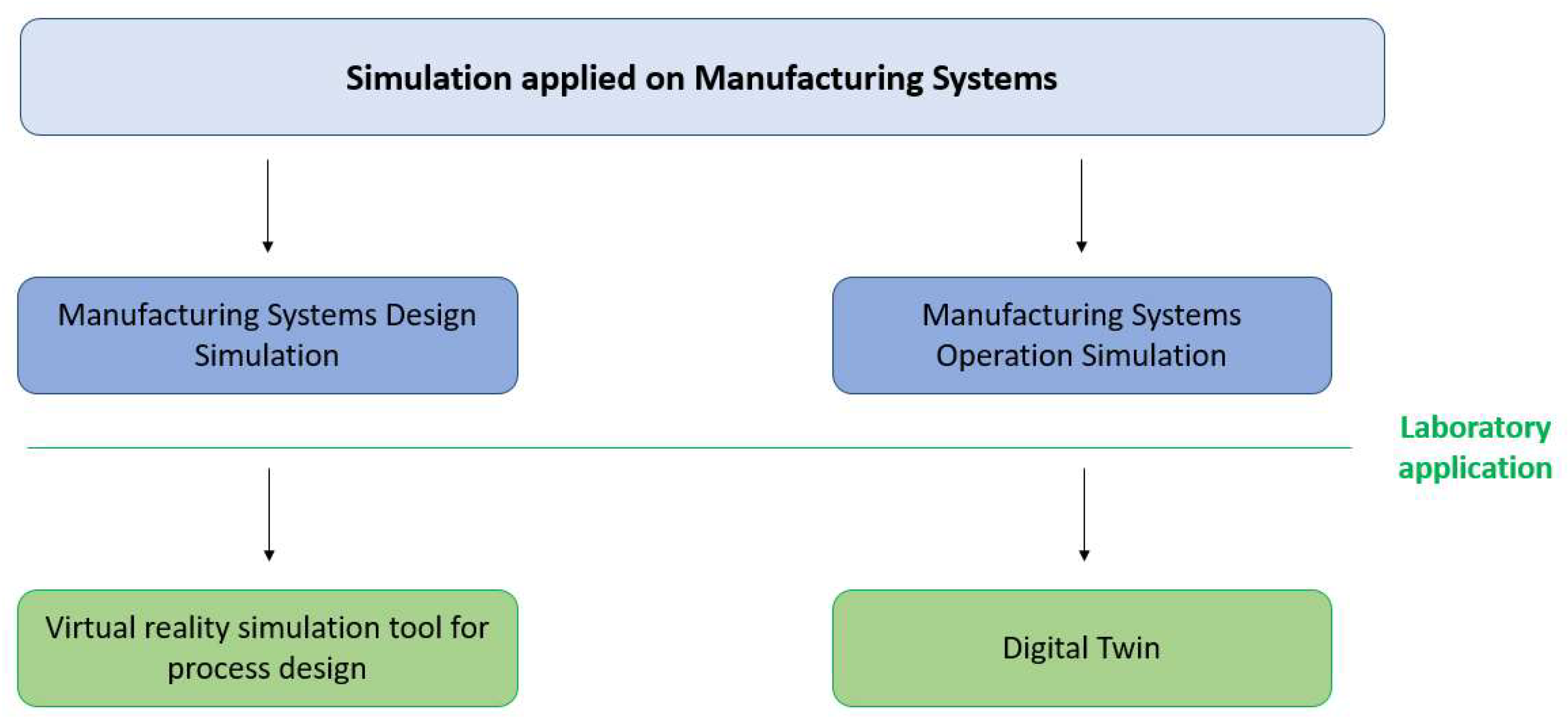
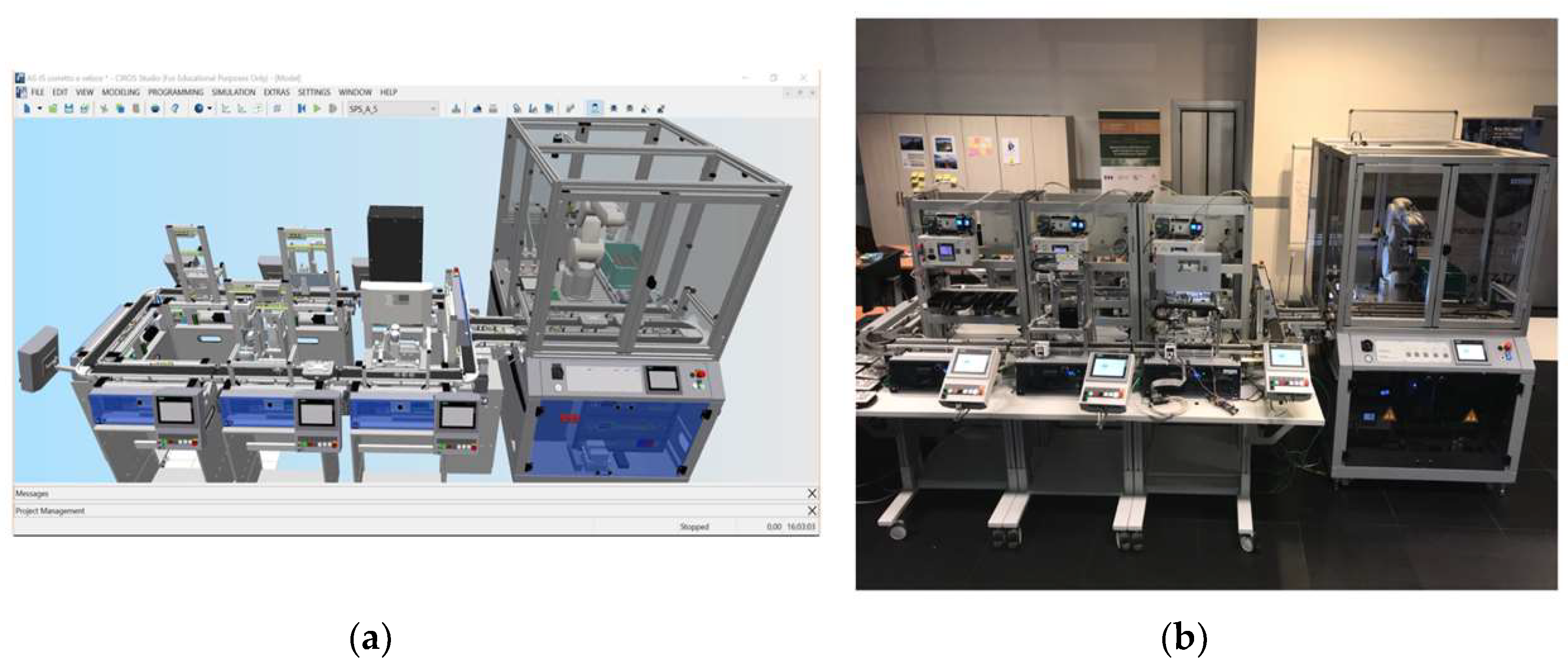
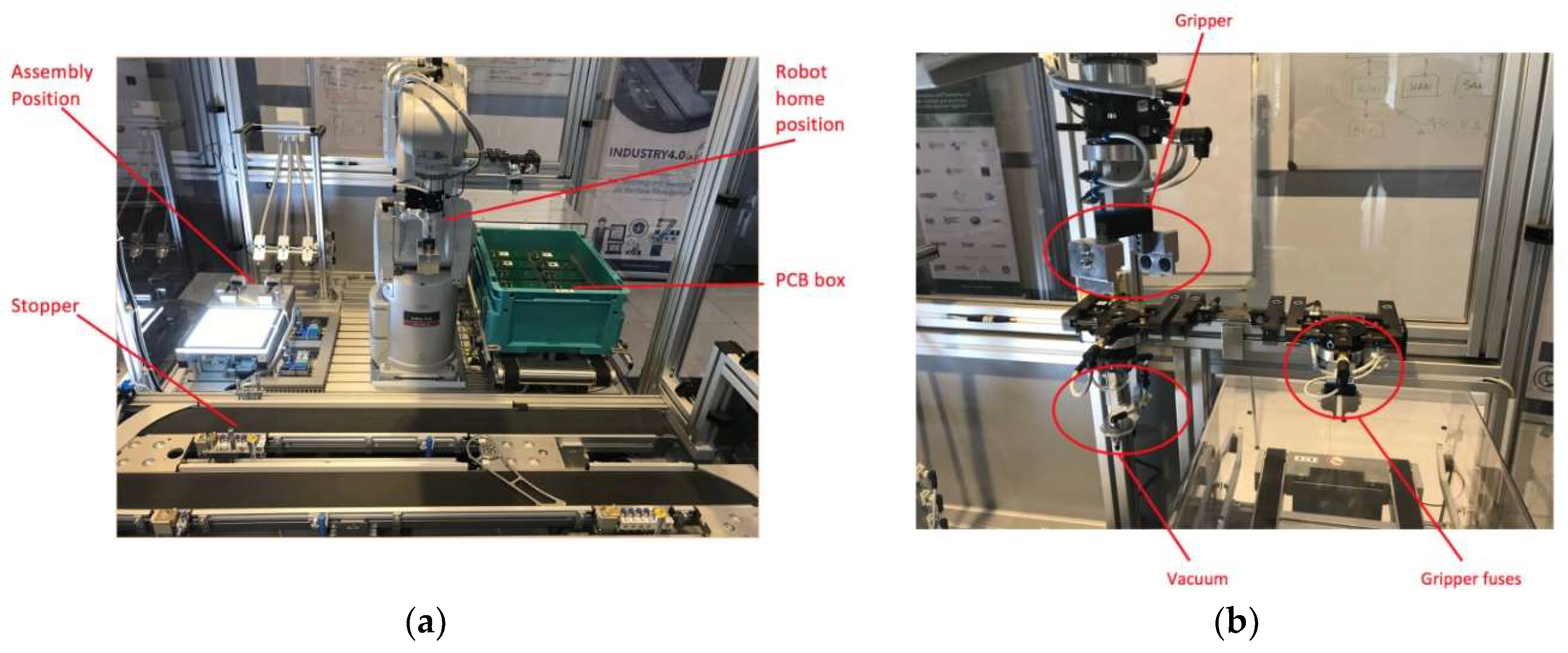
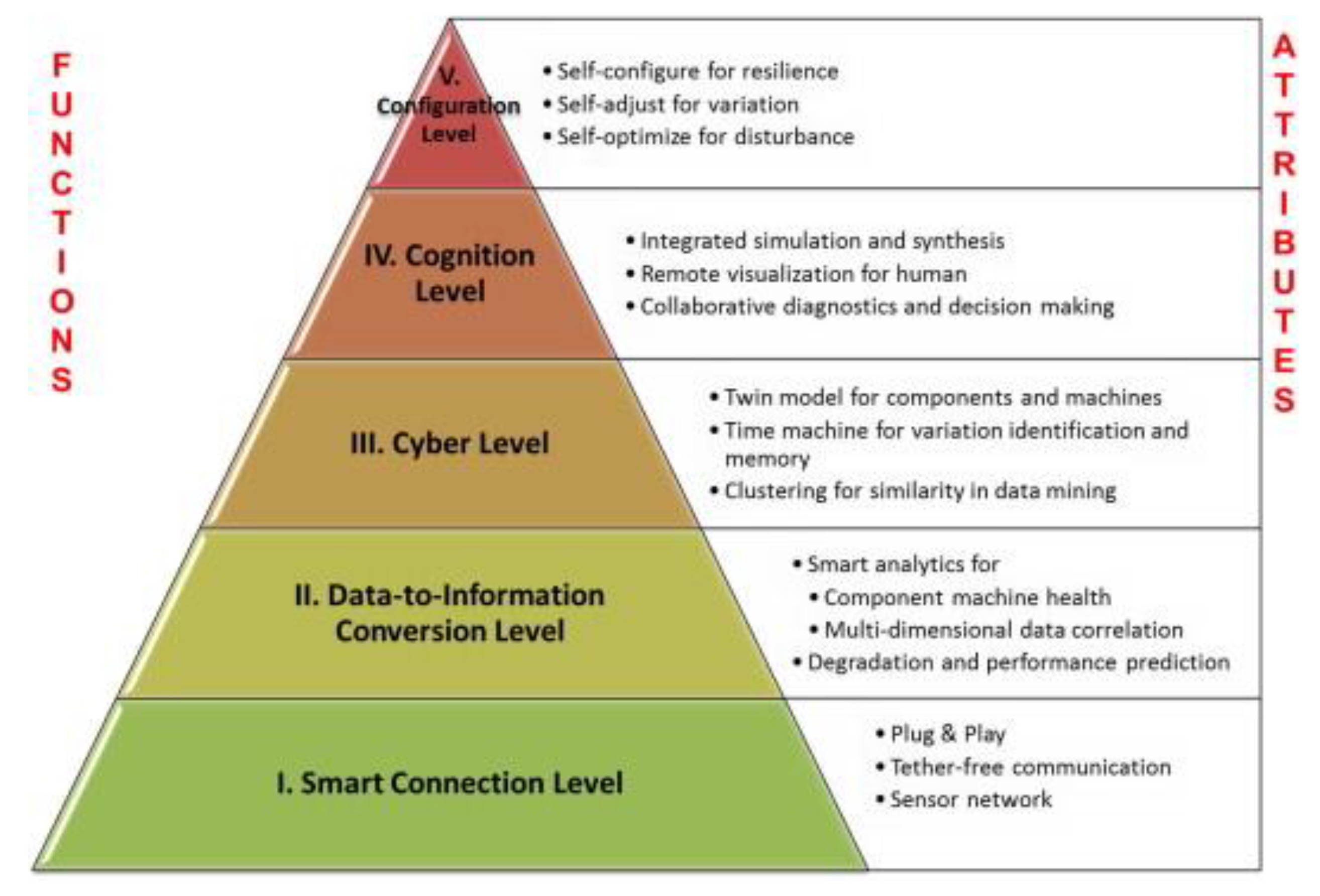
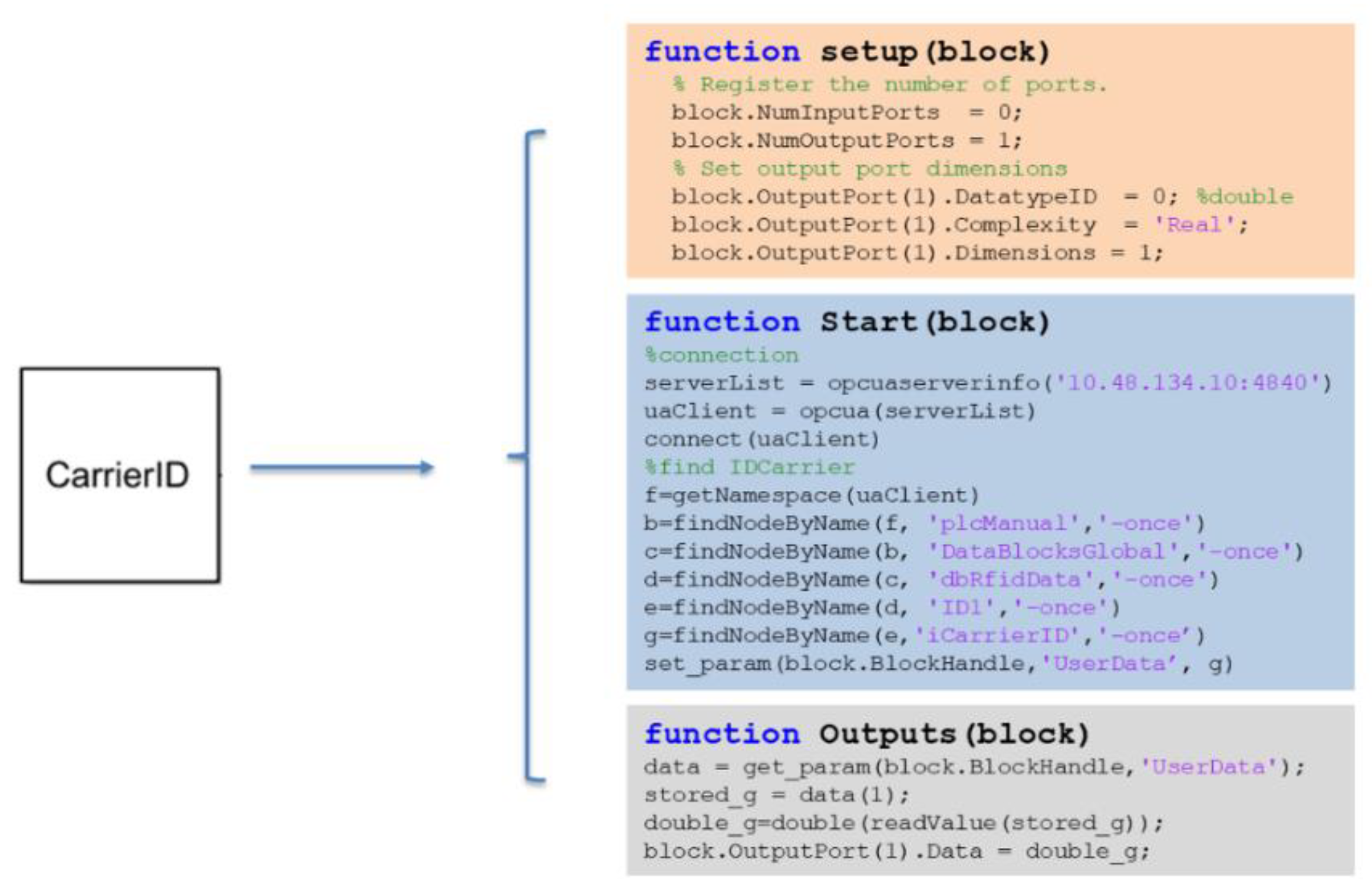


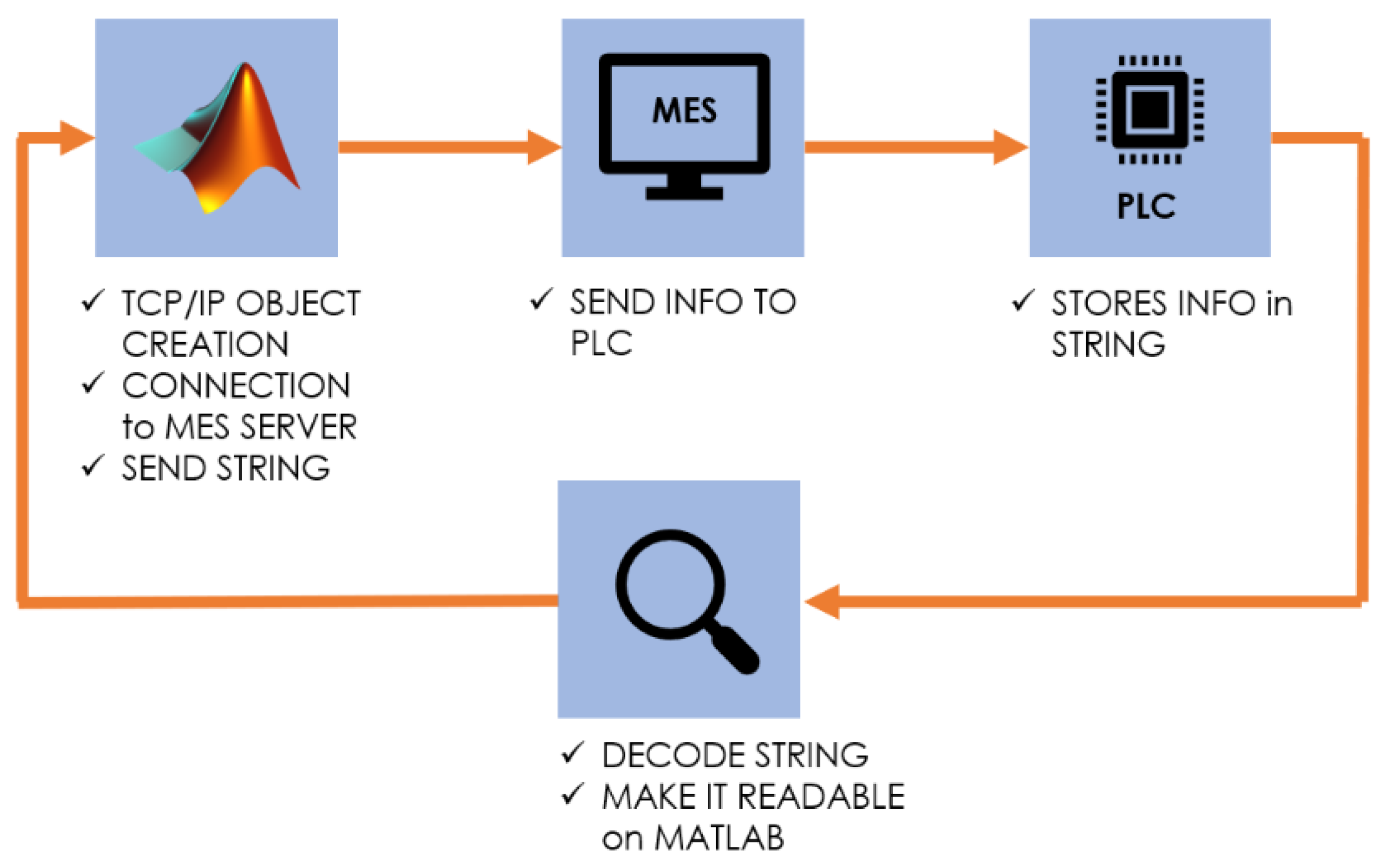
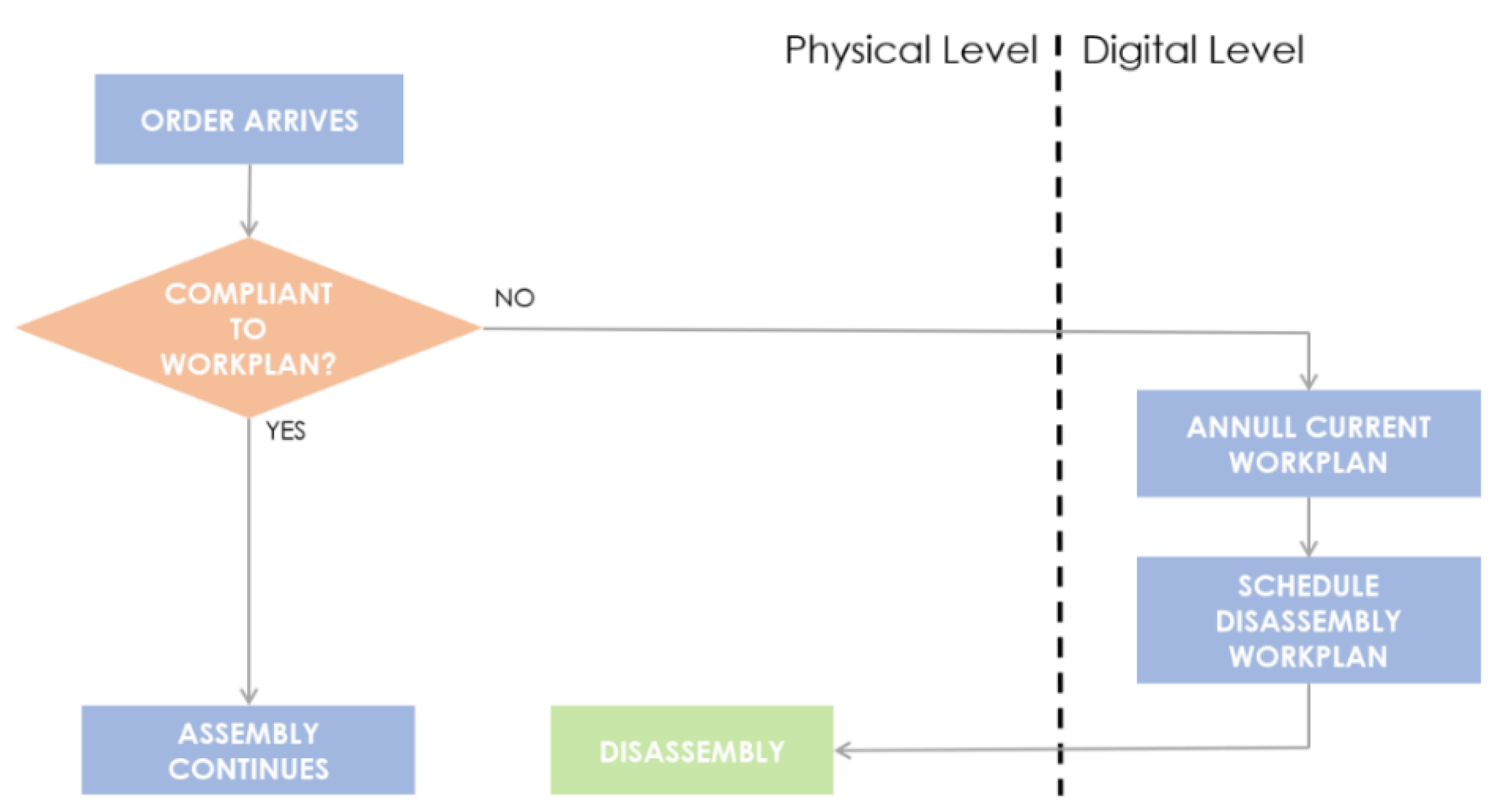
| Command Step | Practical Step |
|---|---|
| serverList = opcuaserverinfo (‘10.48.134.20:4840′) | Connect to the server with the right IP address data |
| uaClient = opcua(serverList) connect(uaClient) f = getNamespace(uaClient) b = findNodeByName(f,’plcMagazineFront’,’once’); k = findNodeByName(b, ’Inputs’,’-once’); I = findNodeByName(k, ’xBG1′,’-once’); | Creation of the client Connect the created client to the server Using the address founded in UA Expert, the user knows the sequence of node to reach the right variable |
| Machine State | Description | Output |
|---|---|---|
| Idle | The conveyor is moving but no operation is performed. The machine is waiting for a piece to be processed. | 1 |
| Working | The machine is performing an operation. | 2 |
| Error | For each of the station of the line, a specific kind of fault have been identified. The machine is blocked due to abnormal behavior and shows an error message in the Human-Machine Interface (HMI). Only when the fault is fixed and the operator respond to the error message on the HMI, the working resumes. | 3 |
| Emergency button | State of the machine that can be classified as a fault state, in which the normal behavior of the machine is stopped due to the fact that the operator has triggered the emergency button. | 4 |
| Energy-saving mode | The machine is on, but the belt is not moving to save energy when there is no piece to work immediately. | 5 |
| Sensor | Description | Values |
|---|---|---|
| xQA_A1 | Sensor used to know if the belt is moving or not | 1 if the belt is moving |
| xBG1 | Sensor used to know if the carrier is in the working position of the station | 1 when the carrier is ready to be processed |
| xBG5 | Entrance sensor of the machine’s belt | 1 when carrier moves over it |
| xBG6 | Exit sensor of the machine’s belt | 1 when carrier moves over it |
| xMB1 | Stopper sensor, that releases the carrier from working position | 1 when activated |
| Sensor | Description |
|---|---|
| xPF1 | It is set to 1 until the operator checks the error on the HMI |
| xPF3 | When is set to 1, the green light of the ’Start’ is turned on to show that the operator must press it to resume the work |
| xSF5 | Set to 1 when the emergency button is released |
| xSF5 | xPF1 | xPF3 | Action | Em.Button |
|---|---|---|---|---|
| 0 | 0 | 0/1 | Button triggered | 1 |
| 1 | 0 | 0/1 | Button released | 1 |
| 1 | 0/1 | 1 | Wait for start | 0 |
| 1 | 1 | 0 | Start triggered | 0 |
| Step | Code | Description |
|---|---|---|
| 1 | t = tcpip (“RemoteHost”, Remote Port); | Creation of TCP/IP object, connected to a remote host (IP address of the MES server) with a remote port |
| 2 | fopen (t); | Connect the TCP/IP object to the host |
| 3 | fprintf (t,sprint(“…”)); | Write in the TCP/IP object (t) the formulation of the string by creating a string variable (sprintf) |
© 2020 by the authors. Licensee MDPI, Basel, Switzerland. This article is an open access article distributed under the terms and conditions of the Creative Commons Attribution (CC BY) license (http://creativecommons.org/licenses/by/4.0/).
Share and Cite
Rocca, R.; Rosa, P.; Sassanelli, C.; Fumagalli, L.; Terzi, S. Integrating Virtual Reality and Digital Twin in Circular Economy Practices: A Laboratory Application Case. Sustainability 2020, 12, 2286. https://doi.org/10.3390/su12062286
Rocca R, Rosa P, Sassanelli C, Fumagalli L, Terzi S. Integrating Virtual Reality and Digital Twin in Circular Economy Practices: A Laboratory Application Case. Sustainability. 2020; 12(6):2286. https://doi.org/10.3390/su12062286
Chicago/Turabian StyleRocca, Roberto, Paolo Rosa, Claudio Sassanelli, Luca Fumagalli, and Sergio Terzi. 2020. "Integrating Virtual Reality and Digital Twin in Circular Economy Practices: A Laboratory Application Case" Sustainability 12, no. 6: 2286. https://doi.org/10.3390/su12062286
APA StyleRocca, R., Rosa, P., Sassanelli, C., Fumagalli, L., & Terzi, S. (2020). Integrating Virtual Reality and Digital Twin in Circular Economy Practices: A Laboratory Application Case. Sustainability, 12(6), 2286. https://doi.org/10.3390/su12062286








